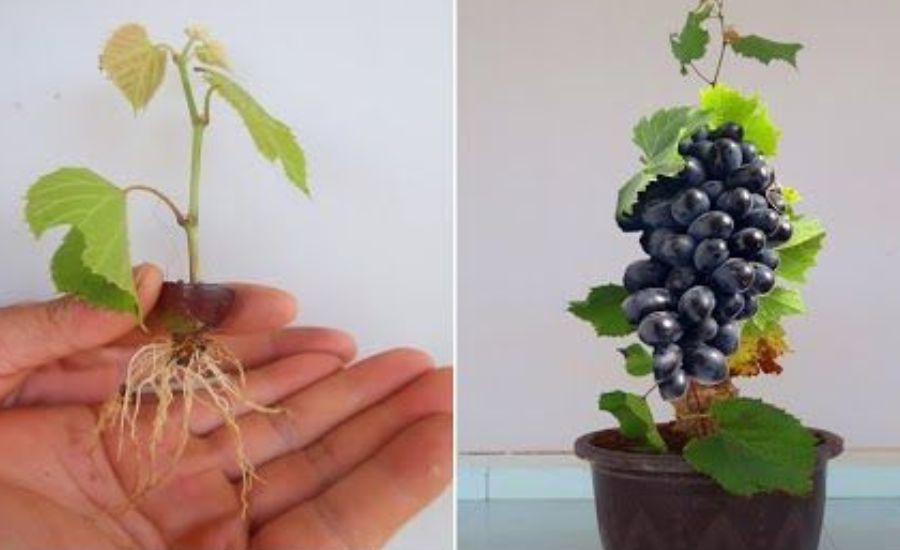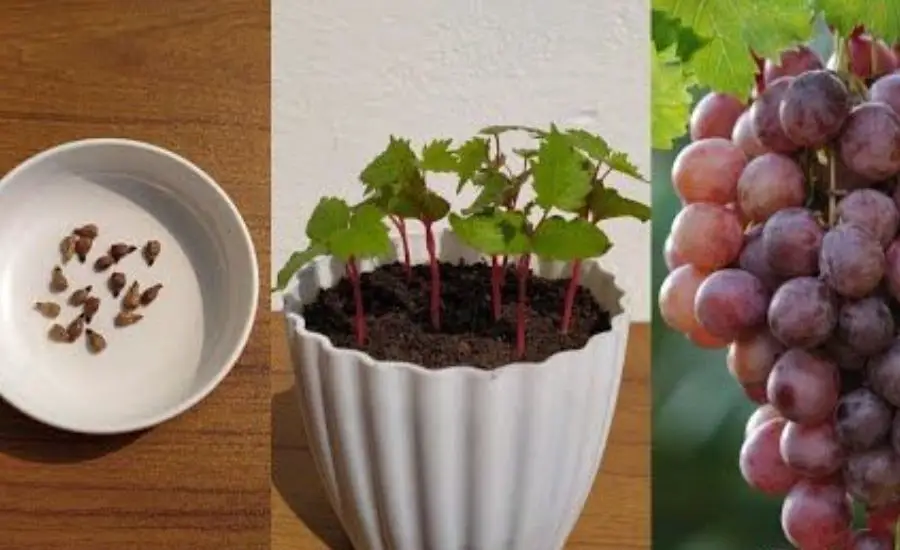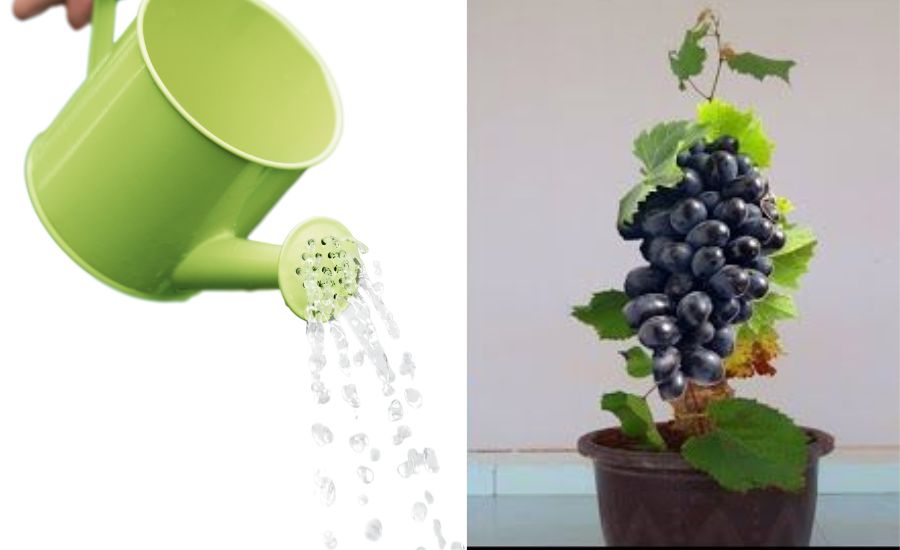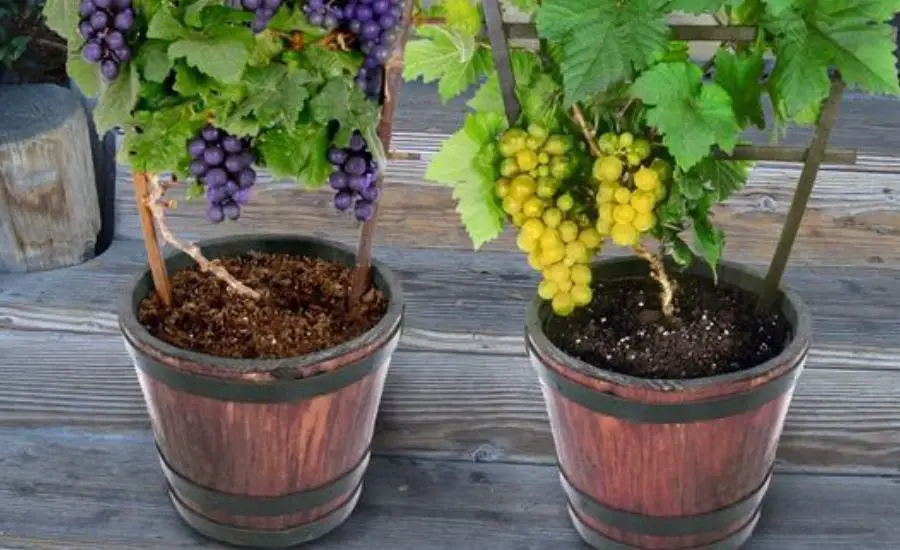How can you grow grapes indoors? Let’s learn all about it here.
Between a tiny grape seedling and a beautiful full-grown grape vine, which will award you with delicious and elegant nectar, there’s a long and bumpy road when a winemaker faces multiple challenges and solves different issues. Growing grapes is not a walk in the park.
It takes passion and dedication. But the result is worth it. Winemakers take great pride in their product, their family businesses continue through multiple generations.
Today, we are adding another challenge for the brave and the curious. We are exploring how to grow grapes indoors. Is it possible at all? It turns out it is.

And it can be a fascinating journey that will bring you to a grand finale: a bottle of wine that you made with your own hands. Amazing, isn’t it?
Let’s see if we are up for a challenge. Where there is a will, there is a way.
Some of us are lucky to have several acres of property suitable for growing grapes and can pursue the art of winemaking. However, the majority doesn’t have that.
But it doesn’t mean that we should admit failure and forget about growing grapes and making wine. We have an absolutely viable option of growing grapes indoors. And although it seems too complex at first sight, it’s totally doable.
Furthermore, it can be an invigorating challenge and a great hobby to take up.
Why don’t we walk through the whole process together so that you can see that growing grapes indoors is achievable and doesn’t require superb gardening skills?
Contents
Getting the supplies
A proper container. As grape vines demand substantial space for their roots to feel comfortable (wide and deep), the container to grow grapes indoors should be relatively large (at least 15 inches in depth and 25 inches in length).
Wood or clay is the best material for it.
Soil suitable for grape vines. The bottom of the pot should be covered with drainage, followed by a thick layer of loose potting mix. Using ordinary garden soil is not advisable for growing grapes indoors.
Our choice is moist silt loam, which is light and perfect for indoor grapes.
A spade. Choose a comfortable spade in the size appropriate for the container.
Fine bamboo sticks, a cotton string, and glue. These supplies you’ll need for training your grapes. They serve as a makeshift trellis for the grape vines to crawl.
Pruning shears. Although this device will not be needed for some time, you can acquire everything in one go.
Grape seeds. A common place to acquire healthy seeds is obviously a nursery. Find the one close to your location and get the number of seeds (e.g., Fosters Seedling) you’ll be able to host.
A tray or a bag for seed germination. Depending on the method you use for germinating the seeds, you can use different containers for that.

First steps to the future winery
Armed with the tools and materials, you are ready to start. What you do first is germinate grape seeds.
1. Germination. Start by ensuring that you are using only healthy seeds by testing them in water (the healthy ones sink, whereas the faulty ones don’t).
20-24 hours of soaking in water (preferably distilled) is enough for the grape seeds.
If you are ready to start the growing season right away, transfer the seeds to the seedling tray and let them germinate for 7-10 days.
2. Preparing the container. As we’ve already pointed out, if you grow grapes indoors, you’ll still need to provide them with reasonable space.
A drainage system is important, too. A potting mix should go up to 50% of the container’s height. Don’t use plastic pots.
They are not reliable. Pottery or wood, on the other hand, are great materials to grow grapes indoors.
3. Planting. Put the seeds in the soil, giving enough space for their roots to develop and cover them. You can also add a layer of compost to provide additional nutrition for the grape plants.
After that, give them plenty of water.

Growing a healthy grape vine
For indoor cultivation to be a success, you shouldn’t forget a few simple rules. They will not steal a lot of your time and may soon become a habit.
1. Water the grapes grown indoors abundantly
Especially at the beginning, make sure that growing indoors grapes are well watered. Daily morning watering can be made into a habit.
Regulate the amount of water in such a way that the soil almost dries up but is never too dry.
Overwatering is not a good option, as root rot can become a serious issue for your fruit production.
So the first growing season requires a lot of water. However, during the second growing season, when your grape vine has become stronger, and the root system is healthy and powerful, the vine will need less moisture.
When watering your grapes, stay away from the leaves. Their excessive moisture may lead to fungal diseases, and we don’t want that.

2. Grapes grown indoors love sunlight
The more light the grapes get, the happier they are. 8 hours of sunlight is perfect for the grapes in and out of the growing season.
If your local conditions don’t allow that, get help from artificial lighting (LED). Switch a timer to 12 hours every day, and your vines will be grateful.
3. Training for the grapes? — Exactly
Vine training is encouraging the vine to grow exactly the way we want it to.
To do that, we’ll need to make a route for the wine to crawl and grow. For that, we take some of our purchased supplies.
We take 2 bamboo stems and place them in the soil on both sides of the pot.
Then we need another stick which we tie to the first ones horizontally with a cotton string.
The horizontal stick should be as high as the stem of the vine.
And the shoots are distributed in a T-shape.
The next step, a.k.a. horizontal stick, will be positioned 18-20 inches higher.
And just like that, you’ll train your vine to climb up.

4. Creating ideal climate
The ideal temperature regime will obviously depend on the grape varieties you’ll choose. Grapes grow and thrive in different climates depending on the sort.
But there are still some general rules that you can adhere to and adjust according to the individual needs of your variety of grapes.
The general rule is to grow grapes in mild temperatures (around 60-62 °F) during the growing season, meaning that starting from early spring and ending in autumn we secure comfortable warmth for our fruit.
Grapes don’t appreciate excessive humidity. They can quickly get sick with powdery mildew disease or a similar illness.
Make sure that you air the room with the plants regularly.
As for the winter months, they are the resting period for the fruit, and the temperature is kept at about 5-6 °F.
5. Essential maintenance: fertilizing and pruning
Both are important and ensure that by the end of the season, you have fruit-bearing vines.
You should begin with an every three weeks fertilizing routine starting in early spring.
Your first choice: nitrogen solutions, they are the best growth stimulants.
Following them, you switch to the solutions rich in potassium. Our potassium fertilizer of choice is tomato plant feed. Its components are absolutely perfect for our fruit.
When you see the fruit ripening, stop fertilizing the soil. You’ve done what you needed to do.
Now to pruning. From spring to autumn, pruning should be done twice.
The first time, it happens when the clusters of grapes are still very small. Take the shears and get rid of some grapes, that will improve the taste and quality of the remaining ones. Fewer grapes — better taste.
The second time, we do it when the ripening grapes are bigger. Taking out some grapes again stimulates the clusters to get bigger.
You can also cut a few stems that would otherwise wind around the main vine and hinder the fruit-growing process.

6. Picking the fruits of your labor
Fall is the season when you can enjoy the fruits of your hard work, and, if you are or want to become a winemaker, it’s the time when you harvest the grapes and make wine from them. You’ve been working hard since early spring, and now it’s time for a reward.
Each grape variety has its harvesting time, but it usually falls in September or October. How do you know that your fruit is ready to be harvested?
You can try them, of course, although if you grow grapes for wine, it may not work out. Grape varieties used for wine production taste nothing like a table grape.
That’s why, you may want to use a visual method. If the seed is no longer white but brownish, and the grape is succulent, it’s most likely ripe enough to be harvested.
Don’t wait until your grapes start to shrivel, it will mean that you are late.
After harvesting, store freshly picked grapes in the fridge in a tightly closed sack or bag. Don’t wash the fruit if you intend to store it. It won’t last this way. Otherwise, you can keep the grapes fresh for up to three weeks.

Best grapes for indoors: a list to choose from
We have prepared a list for you of the best grape varieties for indoor growing. Grapes can be capricious, and it’s better to work with the sorts that have already been successfully tried. Here is the list.
Muscat Romain. That’s a French name, but it is called differently in different countries. It comes from the Mediterranean area and provides a flavorful wine with marmalade tones.
Early Muscat is one of the Muscat varieties featuring early ripening. Early Muscat has a distinctive citrus blossom aroma.
Muscat de Hambourg. Another Muscat that you can opt for the indoor cultivation. Its light flavor can come as a surprise, taking into account the deep ruby color.
A gentle and delightful bouquet of violets and raspberries will not disappoint.
Seyval Blanc. A French grape cultivated from 2 legendary sorts: Chardonnay and Sauvignon Blanc. It makes a delightful white wine with notes of citrus, melon, and hey, perfect for a hot summer evening.
Royal Muscadine. This grape is usually used for producing sweet wines with an intense aroma and notes of bananas, cranberries, and bruised apples.

Final thoughts
As you can see, indoor grape cultivation is not overly complex. Yes, it takes time and effort, but if you like the gardening challenge or if you are an enthusiastic winemaker who wants to control the entire process starting with producing your grapes, that can be an interesting and challenging endeavor for you.
Even if you are not keen on making wine, grapes can be used in other ways, too. Make sweet, delicious grape juice or jelly, and your family will be delighted.
We are encouraging you to consider this adventure of growing indoor grapes.
Frequently asked questions
Can you grow grapevines inside?
Yes, it’s possible, but you will still need some space as the vines require spacious containers to grow comfortably.
How long does it take to grow grapes?
It takes at least three years for the vine to start producing grapes.
Can grapes live through winter?
Yes, grapes get dormant and live through winter at approximately 5 °F.
How long does it take to grow grapes at home?
It takes at least 3 years for the vine to start bearing fruit.
A garden is a place that relaxes us and reflects our personal style, it’s a place to spend time with loved ones and grow our own fruits and vegetables. Maybe you’re looking for design inspiration or plant selection, or you’re concerned about garden privacy, shady areas, or pests, but don’t worry, you’ve come to the right place.

